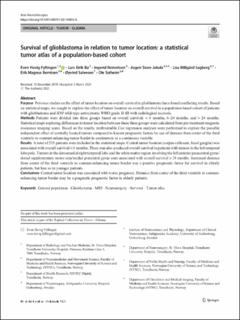| dc.contributor.author | Fyllingen, Even Hovig | |
| dc.contributor.author | Bø, Lars Eirik | |
| dc.contributor.author | Reinertsen, Ingerid | |
| dc.contributor.author | Jakola, Asgeir Store | |
| dc.contributor.author | Sagberg, Lisa Millgård | |
| dc.contributor.author | Berntsen, Erik Magnus | |
| dc.contributor.author | Salvesen, Øyvind | |
| dc.contributor.author | Solheim, Ole | |
| dc.date.accessioned | 2021-04-06T12:12:24Z | |
| dc.date.available | 2021-04-06T12:12:24Z | |
| dc.date.created | 2021-03-20T09:36:07Z | |
| dc.date.issued | 2021 | |
| dc.identifier.issn | 0001-6268 | |
| dc.identifier.uri | https://hdl.handle.net/11250/2736396 | |
| dc.description.abstract | Purpose
Previous studies on the effect of tumor location on overall survival in glioblastoma have found conflicting results. Based on statistical maps, we sought to explore the effect of tumor location on overall survival in a population-based cohort of patients with glioblastoma and IDH wild-type astrocytoma WHO grade II–III with radiological necrosis.
Methods
Patients were divided into three groups based on overall survival: < 6 months, 6–24 months, and > 24 months. Statistical maps exploring differences in tumor location between these three groups were calculated from pre-treatment magnetic resonance imaging scans. Based on the results, multivariable Cox regression analyses were performed to explore the possible independent effect of centrally located tumors compared to known prognostic factors by use of distance from center of the third ventricle to contrast-enhancing tumor border in centimeters as a continuous variable.
Results
A total of 215 patients were included in the statistical maps. Central tumor location (corpus callosum, basal ganglia) was associated with overall survival < 6 months. There was also a reduced overall survival in patients with tumors in the left temporal lobe pole. Tumors in the dorsomedial right temporal lobe and the white matter region involving the left anterior paracentral gyrus/dorsal supplementary motor area/medial precentral gyrus were associated with overall survival > 24 months. Increased distance from center of the third ventricle to contrast-enhancing tumor border was a positive prognostic factor for survival in elderly patients, but less so in younger patients.
Conclusions
Central tumor location was associated with worse prognosis. Distance from center of the third ventricle to contrast-enhancing tumor border may be a pragmatic prognostic factor in elderly patients. | en_US |
| dc.language.iso | eng | en_US |
| dc.publisher | Springer | en_US |
| dc.rights | Navngivelse 4.0 Internasjonal | * |
| dc.rights.uri | http://creativecommons.org/licenses/by/4.0/deed.no | * |
| dc.title | Survival of glioblastoma in relation to tumor location: a statistical tumor atlas of a population-based cohort | en_US |
| dc.type | Peer reviewed | en_US |
| dc.type | Journal article | en_US |
| dc.description.version | publishedVersion | en_US |
| dc.subject.nsi | VDP::Radiologi og bildediagnostikk: 763 | en_US |
| dc.subject.nsi | VDP::Radiology and diagnostic imaging: 763 | en_US |
| dc.subject.nsi | VDP::Radiologi og bildediagnostikk: 763 | en_US |
| dc.subject.nsi | VDP::Radiology and diagnostic imaging: 763 | en_US |
| dc.source.journal | Acta Neurochirurgica | en_US |
| dc.identifier.doi | 10.1007/s00701-021-04802-6 | |
| dc.identifier.cristin | 1899582 | |
| cristin.ispublished | true | |
| cristin.fulltext | original | |
| cristin.qualitycode | 1 | |

